Bosnia-Herzegovina
Bosnia-Herzegovina new sig/date (2017) notes confirmed
08 07, 2017 07:22 Category: Europe
The Central Bank of Bosnia and Herzegonvina has apparently introduced revised notes of all denominations except 20 maraka. The notes have new date (2017) and new signature (Senad Softić).
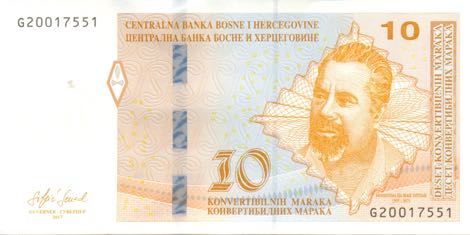
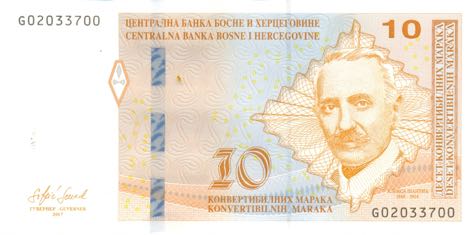
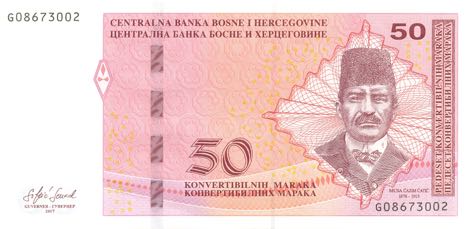


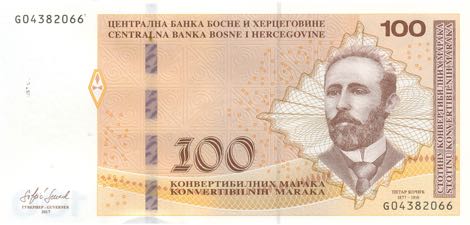
Courtesy of Claudio Marana and Leo Reich.






Courtesy of Claudio Marana and Leo Reich.
Republika Srpska chapter of The Banknote Book is now available
17 09, 2015 10:43 Category: The Banknote Book | Europe
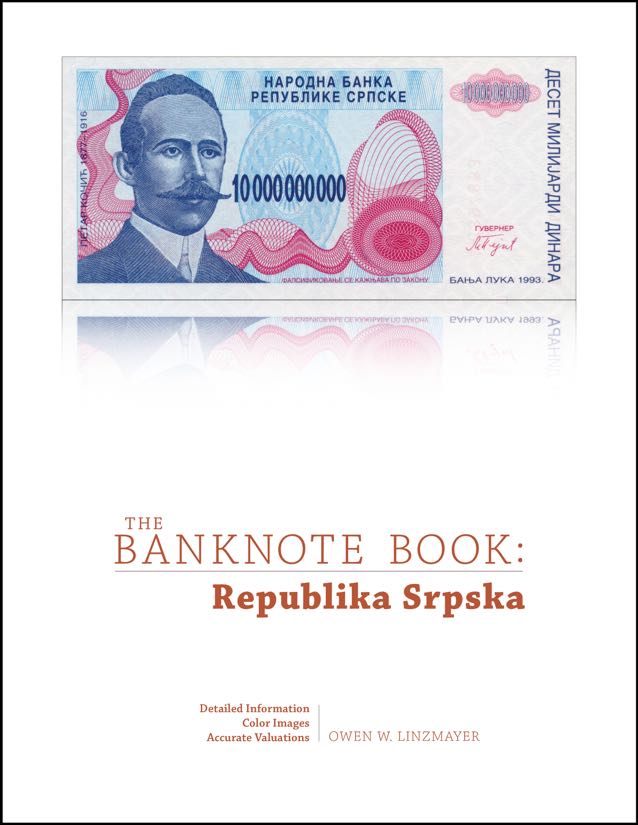
The Republika Srpska chapter of The Banknote Book is now available for individual sale and as a free download to subscribers.
This 8-page catalog covers notes issued by the Narodna Banka Srpske Republike Bosne I Hercegovine (National Bank of the Serbian Republic of Bosnia and Herzegovina) from 1992 to 1993, and the Narodna Banka Republike Srpske (National Bank of the Serbian Republic) from 1993 to 1995. Published 18 September 2015.
Each chapter of The Banknote Book includes detailed descriptions and background information, full-color images, and accurate valuations. The Banknote Book also features:
- Sharp color images of note’s front and back without overlap
- Face value or date of demonetization if no longer legal tender
- Specific identification of all vignette elements
- Security features described in full
- Printer imprint reproduced exactly as on note
- Each date/signature variety assigned an individual letter
- Variety checkboxes for tracking your collection and want list
- Date reproduced exactly as on note
- Precise date of introduction noted when known
- Replacement note information
- Signature tables, often with names and terms of service
- Background information for historical and cultural context
- Details magnified to distinguish between note varieties
- Bibliographic sources listed for further research
Subscribe to The Banknote Book
If you collect the entire world or a large number of countries, buying a subscription is the best deal because it's less expensive than buying chapters individually, and it entitles you to every chapter currently available as well as everything published—or revised (click here to see the Change Log)—during the term of your subscription.

Sign up for Email Notifications
If you would like to receive email notifications whenever a new chapter of The Banknote Book is published, please join the email list by clicking the button below.

Book review: Coins and Banknotes of Yugoslavia, Slovenia, Croatia, Bosnia and Herzegovina, Serbia, Montenegro and Macedonia
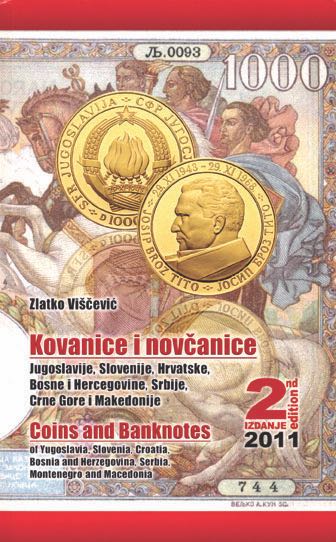
Coins and Banknotes of Yugoslavia, Slovenia, Croatia, Bosnia and Herzegovina, Serbia, Montenegro and Macedonia
Zlatko Viščević, 1173 pages, soft cover, 192 x 120 mm, black and white illustrations, Croatian and English, ISBN 978-953-56890-0-3, US$52 / €40 (free shipping), kin2.orders@gmail.com
Download the free sample chapter: Coins and Banknotes of the Kingdom of Yugoslavia.
Reviewed by Owen W. Linzmayer 7962
As author Zlatko Viščević mentions in the introduction to his impressive new catalog, collecting banknotes from the area of the former Yugoslavia can be quite challenging due to the large number of notes issued over the years. Compounding the problem is the Serbo-Croatian text on these notes and the complicated history of the region, both of which may be unfamiliar to many collectors. This new catalog doesn’t attempt to explain the tumultuous politics of the past three centuries, but is an invaluable addition to the reference library of anyone who specializes in collecting notes from this part of the world.
The first edition of this catalog was published in 2007. The second edition covers regular and commemorative notes issued in the intervening years, goes into greater depth in the descriptions, and now also includes special, fantasy, and private issues. In short, if you already own the first edition and like it, you’ll definitely want to buy the much-improved and expanded second edition.
Coins and Banknotes’ title spells out exactly what’s inside. The first half of the book is devoted to coins, the second half to notes, with chapters for the seven countries in each section. Within the chapters, the coins and notes are listed chronologically by denomination, which makes it easy to locate a particular piece and track changes over time, but at the expense of presenting complete families with common or complementary designs.
Each note type listing contains the denomination, catalog number, cross-references to Pick numbers and other specialized catalogs, reduced-size illustrations of the front and back, description of design elements and security features, and finally a list of varieties, with checkboxes for tracking your collection. Each variety is assigned a six-level rarity rating, and has values in euros for up to four levels of condition. Some notes also have auction results at the bottom of the page, though the values and results don’t always agree. Occasionally there are inset illustrations of details which determine varieties. These are useful in most cases, but sometimes the differences aren’t obvious due to the small size or lack of color in their reproduction.
Specialized collectors will appreciate the comprehensive lists of prefixes, as well as the inclusion of specimen and replacement notes in the variety tables, not to mention the assortment of “irregular issues” (color trials, partial proofs, etc.) and private/fantasy notes covered separately. While there isn’t much explanatory text regarding these issues, anyone interested in pursuing further research can consult the bibliography of source books and web sites at the end of each chapter.
The longer passages of prose in the catalog are presented in both Croatian and English, but the descriptions of the notes and their varieties are in Croatian only, which is a little frustrating if you care about such details and don’t want to rely upon Google Translate. Fortunately the English text everywhere else in the book is good enough that it’s easy to overlook the minor typos and understand the gist of the intended meaning.
One complaint I have about the catalog is its size. This is a bulky, compact tome measuring a whopping 55 millimeters thick, and heavy enough to break a toe if dropped on a foot. I would have preferred the coin and banknote sections split into two separate volumes, both printed in a larger format. As it is, the small black and white illustrations don’t do justice to the beauty of the notes, and the tiny text is hard to read if your eyesight isn’t perfect.
With this second edition, Zlatko Viščević has created a solid reference for collectors of notes of Yugoslavia and its constituent republics from 1849 to 2011. Coins and Banknotes delivers a dense helping of numismatic information at price that can’t be beat.
Book Review: Coins and Banknotes of Yugoslavia, Slovenia, Croatia, Bosnia and Herzegovina, Serbia, Montenegro and Macedonia

Coins and Banknotes of Yugoslavia, Slovenia, Croatia, Bosnia and Herzegovina, Serbia, Montenegro and Macedonia
Zlatko Viščević, 1173 pages, soft cover, 192 x 120 mm, black and white illustrations, Croatian and English, ISBN 978-953-56890-0-3, US$52 / €40 plus shipping, www.hrvatskanumizmatika.net
Download the free sample chapter: Coins and Banknotes of the Kingdom of Yugoslavia.
Reviewed by Owen W. Linzmayer 7962
As author Zlatko Viščević mentions in the introduction to his impressive new catalog, collecting banknotes from the area of the former Yugoslavia can be quite challenging due to the large number of notes issued over the years. Compounding the problem is the Serbo-Croatian text on these notes and the complicated history of the region, both of which may be unfamiliar to many collectors. This new catalog doesn’t attempt to explain the tumultuous politics of the past three centuries, but is an invaluable addition to the reference library of anyone who specializes in collecting notes from this part of the world.
The first edition of this catalog was published in 2007. The second edition covers regular and commemorative notes issued in the intervening years, goes into greater depth in the descriptions, and now also includes special, fantasy, and private issues. In short, if you already own the first edition and like it, you’ll definitely want to buy the much-improved and expanded second edition.
Coins and Banknotes’ title spells out exactly what’s inside. The first half of the book is devoted to coins, the second half to notes, with chapters for the seven countries in each section. Within the chapters, the coins and notes are listed chronologically by denomination, which makes it easy to locate a particular piece and track changes over time, but at the expense of presenting complete families with common or complementary designs.
Each note type listing contains the denomination, catalog number, cross-references to Pick numbers and other specialized catalogs, reduced-size illustrations of the front and back, description of design elements and security features, and finally a list of varieties, with checkboxes for tracking your collection. Each variety is assigned a six-level rarity rating, and has values in euros for up to four levels of condition. Some notes also have auction results at the bottom of the page, though the values and results don’t always agree. Occasionally there are inset illustrations of details which determine varieties. These are useful in most cases, but sometimes the differences aren’t obvious due to the small size or lack of color in their reproduction.
Specialized collectors will appreciate the comprehensive lists of prefixes, as well as the inclusion of specimen and replacement notes in the variety tables, not to mention the assortment of “irregular issues” (color trials, partial proofs, etc.) and private/fantasy notes covered separately. While there isn’t much explanatory text regarding these issues, anyone interested in pursuing further research can consult the bibliography of source books and web sites at the end of each chapter.
The longer passages of prose in the catalog are presented in both Croatian and English, but the descriptions of the notes and their varieties are in Croatian only, which is a little frustrating if you care about such details and don’t want to rely upon Google Translate. Fortunately the English text everywhere else in the book is good enough that it’s easy to overlook the minor typos and understand the gist of the intended meaning.
One complaint I have about the catalog is its size. This is a bulky, compact tome measuring a whopping 55 millimeters thick, and heavy enough to break a toe if dropped on a foot. I would have preferred the coin and banknote sections split into two separate volumes, both printed in a larger format. As it is, the small black and white illustrations don’t do justice to the beauty of the notes, and the tiny text is hard to read if your eyesight isn’t perfect.
With this second edition, Zlatko Viščević has created a solid reference for collectors of notes of Yugoslavia and its constituent republics from 1849 to 2011. Coins and Banknotes delivers a dense helping of numismatic information at price that can’t be beat.
Bosnia and Herzegovina new notes confirmed
09 06, 2012 09:29 Category: Europe



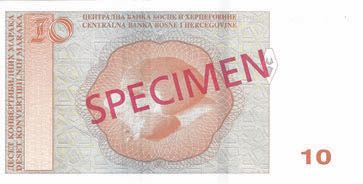








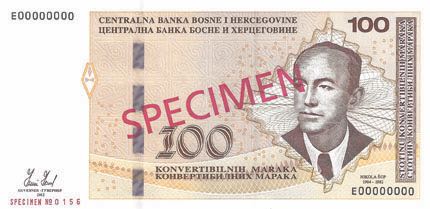



According to a press release dated 23 May 2012, the Central Bank of Bosnia and Herzegovina issued new banknotes denominated in 10, 20, 50, and 100 marka (US$7.10-$71) on 1 June 2012. The new notes dated 2012 feature the same designs as the preceding issues, but improved paper quality, and enhanced security, including multi-tone and electrotype watermarks, Motion and solid security threads with demetalized text, iridescent stripes, microprinting, UV ink, and optically variable inks. Both issued and specimen varieties have been confirmed.
Courtesy of Sami Kiuru, Mojmir Cerny, and James Pickering (www.e-worldbanknotes.com or James@e-worldbanknotes.com).
Bosnia and Herzegovina removing 5-convertible marka note from circulation
04 03, 2010 08:25 Category: Europe
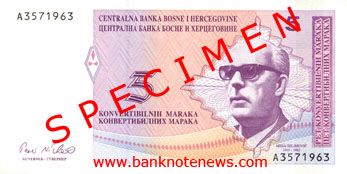
The Central Bank of Bosnia and Herzegovina (CBBH) is reminding citizens in possession of 5-convertible marka (US$3.50) notes that they have until 31 March 2010 to exchange them at commercial banks. The note ceased to be legal tender on 31 December 2009 and as such are no longer accepted in circulation for settlement of any type of liabilities. A coin of the same denomination remains in circulation.
Bosnia and Herzegovina new date (2009) 50-convertible marka note confirmed
02 03, 2010 17:43 Category: Europe



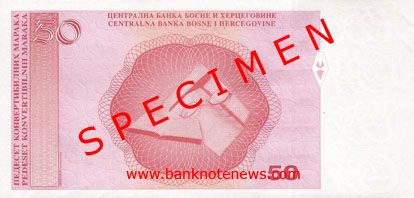

On 14 December 2009, the Central Bank of Bosnia and Herzegovina (CBBH) introduced a 50-convertible marka (US$36.60) note like Pick 72, but dated 2009 and a new signature (Kemal Kozanic).
Courtesy of Kovács Sándor and Jean-Michel Engels.
Bosnia and Herzegovina new date (2008) KM notes confirmed
04 03, 2009 18:21 Category: Europe


These convertible marka notes are like the preceding issues, but new date (2008), new signature (Kemel Kozarić, GUVERNER), and windowed security threads.
Reportedly 50 and 100 KM notes dated 2007 were also issued in both Fed. BiH and Serb Rep. varieties. IIf anyone has these notes, please send scans so that they can be confirmed.
Courtesy of Claudio Marana and banknoteshop@gmx.net.
Bosnia and Herzegovina chapter of The Banknote Book is now available
31 05, 2018 10:37 Category: The Banknote Book | Europe

The Bosnia and Herzegovina chapter of The Banknote Book is now available for individual sale and as a free download to subscribers.
This 24-page catalog covers notes issued by Narodna Banka Bosne I Hercegovine (National Bank of Bosnia and Herzegovina) from 1990 to 1995, and Centralna Banka Bosne I Hercegovine (Central Bank of Bosnia and Herzegovina) from 1998 to present. Published 01.06.2018.
Each chapter of The Banknote Book includes detailed descriptions and background information, full-color images, and accurate valuations. The Banknote Book also features:
- Sharp color images of note’s front and back without overlap
- Face value or date of demonetization if no longer legal tender
- Specific identification of all vignette elements
- Security features described in full
- Printer imprint reproduced exactly as on note
- Each date/signature variety assigned an individual letter
- Variety checkboxes for tracking your collection and want list
- Date reproduced exactly as on note
- Precise date of introduction noted when known
- Replacement note information
- Signature tables, often with names and terms of service
- Background information for historical and cultural context
- Details magnified to distinguish between note varieties
- Bibliographic sources listed for further research
Subscribe to The Banknote Book
If you collect the entire world or a large number of countries, buying a subscription is the best deal because it's less expensive than buying chapters individually, and it entitles you to every chapter currently available as well as everything published—or revised (click here to see the Change Log)—during the term of your subscription.

Sign up for Email Notifications
If you would like to receive email notifications whenever a new chapter of The Banknote Book is published, please join the email list by clicking the button below.


